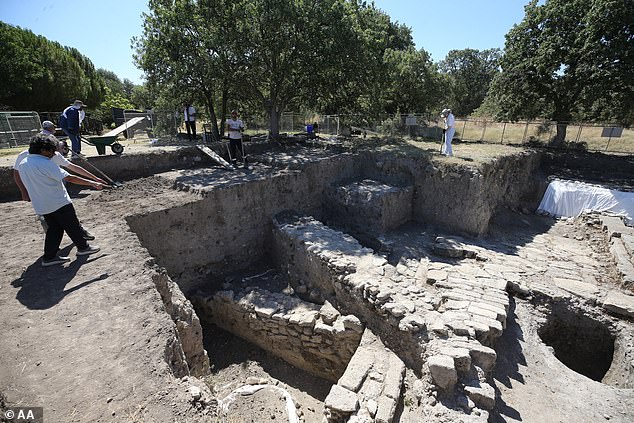For centuries, Homer’s Iliad has captivated the world with tales of gods, glory, and a wooden horse that toppled a city.
While many dismissed it as epic poetry with no factual basis, fresh discoveries from a recent excavation at Troy are now reviving the debate: could there have been a real battle behind the legend?
Fresh Dig Reveals Alarming Signs of Sudden Warfare
A group of Turkish archaeologists digging at the ancient city of Troy have made a remarkable discovery—one that points toward a violent conflict from around 3,200 to 3,600 years ago.
Found just outside what would have been the palace walls were dozens of clay sling stones and smoothed river rocks—projectiles designed for deadly impact.
Scattered among them were arrowheads, burned structures, and human skeletons hastily buried, all pointing to sudden violence.
“This kind of density of sling stones in one place tells us there was intense combat here,” explained Professor Rustem Aslan from Canakkale Onsekiz Mart University, who’s leading the research team.
“It might have been a desperate last defense or a massive assault.”
Deadly Sling Stones Offer a Glimpse into Bronze Age Combat
The smooth stones, carefully shaped for speed and accuracy, were no ordinary rocks.
In the Bronze Age, these aerodynamic projectiles, when flung with force from a leather sling, could crush skulls at considerable distances.
The ones found at Troy date back to the very time historians place the legendary Trojan War—around 1184 BC.
This isn’t just a random find.
It appears to capture the chaos of a brutal confrontation that ended in disaster.
Archaeologists now believe the evidence strongly suggests a catastrophic military attack, eerily echoing Homer’s story.
The Iliad’s War May Not Be Pure Myth After All
For a long time, the world viewed the Iliad as pure fiction—a poetic tale about Paris stealing Helen and triggering a ten-year Greek siege that ended with a wooden horse trick.
But the more researchers dig, the more the narrative shifts.
This summer’s excavation, part of Turkey’s Legacy for the Future Project, specifically targeted the city’s palace, public square, and defenses—and what they found there could reshape how we understand the past.
Among the discoveries were not just weapons and building ruins, but personal items like bone tools, armor-piercing points, and even a knucklebone likely used in games—tiny hints of the people who lived and fought there.
A Burned City and Hastily Buried Dead Tell a Tragic Story
A layer of destruction, first discovered in 2024 and further explored this year, has become a focal point of the dig.
It contains widespread fire damage, shattered weapons, and signs of emergency burials.
This wasn’t a city that faded quietly into history—it was one that fell violently, possibly in one night.
Adding to the weight of the discovery are earlier finds from the same location: arrowheads and weapon fragments that suggest close-quarter battles.
Taken together, the evidence paints a picture of desperate last stands and a city overwhelmed by assault.
Ancient Texts, Modern Science, and a Merging Narrative
What makes these discoveries so compelling is how they match the written accounts from ancient historians.
Herodotus and Eratosthenes, writing centuries after the supposed war, both insisted the Trojan War was a real event.
Roman poet Virgil later picked up the tale in the Aeneid, telling of Troy’s fall and how one survivor, Aeneas, journeyed to eventually establish the roots of Rome.
These aren’t just myths anymore—they may be folk memories passed down through generations, grounded in something real.
Troy’s Strategic Importance Made It a Prime Target
Troy wasn’t some sleepy, isolated settlement.
Positioned near the Dardanelles, it was a wealthy and strategically vital hub linking Europe and Asia.
Its thick stone walls, lookout towers, and carefully planned urban layout show it was built for both trade and defense.
That kind of value would make any ancient power eye it hungrily—and may explain why it found itself at the center of such a fierce conflict.
The War-Torn Years of the Bronze Age Collapse
Historians agree that the period from 1500 to 1200 BC—precisely when Troy was active—was marked by upheaval across the Mediterranean.
Civilizations crumbled under pressure from invasions, uprisings, and migration.
Troy might have been swept up in this larger wave of destruction, its fall just one piece of a broader Bronze Age collapse.
And perhaps, Homer’s tale is a poetic interpretation of those very real, very devastating events.
No Wooden Horse… Yet
Despite all the finds, one iconic element remains elusive: the infamous wooden horse.
There’s no hard evidence for it—no carvings, models, or remains.
Historians continue to speculate that the “horse” might have been a metaphor for betrayal, subterfuge, or even a siege engine misinterpreted through the ages.
Still, the absence of the horse doesn’t diminish the powerful story told by the charred ruins and scattered weapons left behind.
What Comes Next for Troy’s Excavation?
The findings have sparked renewed excitement in the archaeological community, and digs are expected to continue over the coming seasons.
As researchers carefully peel back more layers of Troy’s history, they hope to answer lingering questions about what really happened in this legendary city.
Did the events of The Iliad reflect historical truths hidden behind poetic flourishes?
With every stone, every arrowhead, and every skeleton, the ancient city may yet tell the real story behind the myth.



